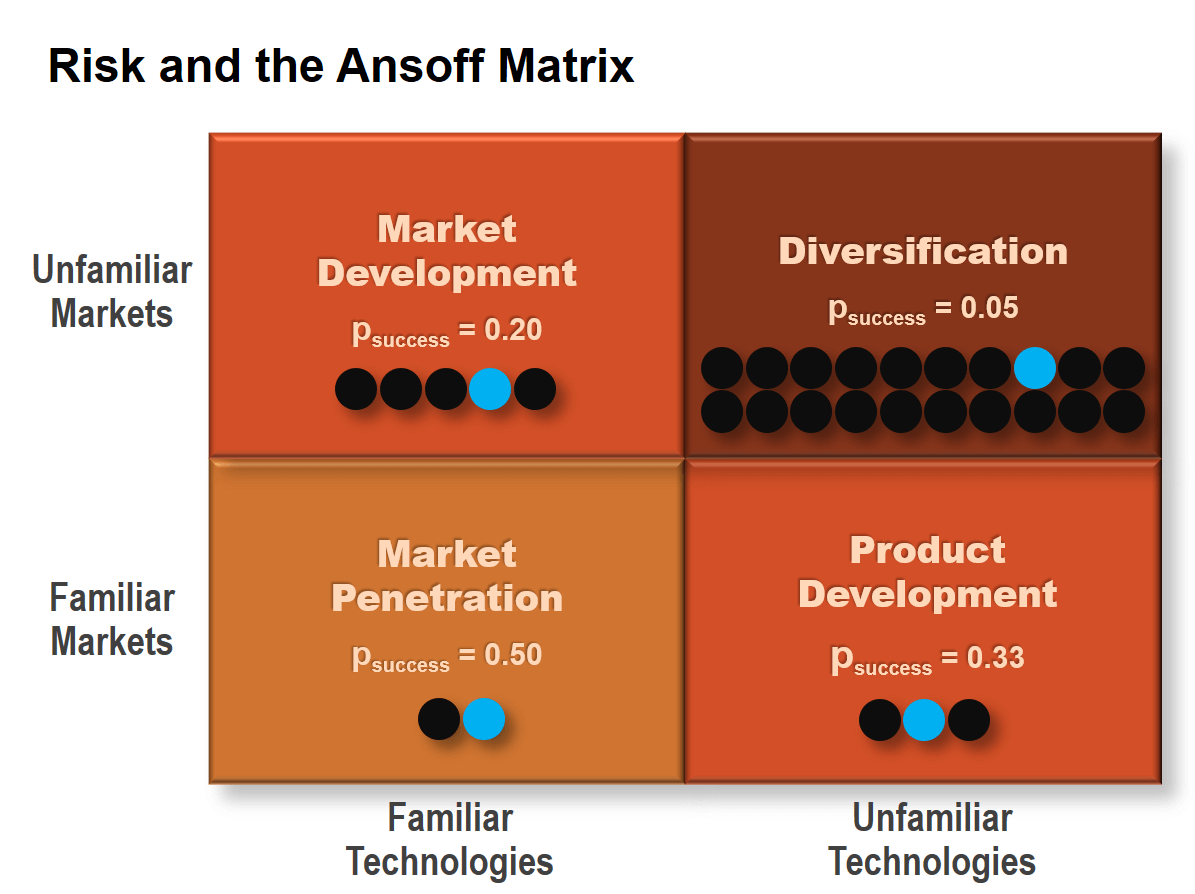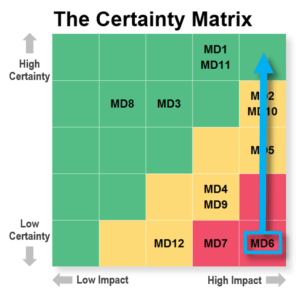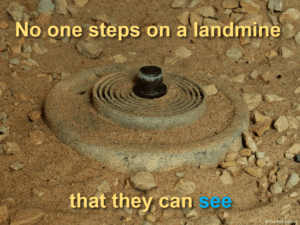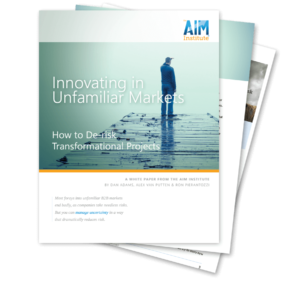De-Risking Innovation: How to Thrive in the “Suicide Quadrant”

De-risking innovation is the process of increasing certainty for each assumption that must be true for our riskier endeavors to succeed. But is this even possible? Many companies fear the “diversification” quadrant, where their chances of success are only one in twenty. It’s time to embrace the concept of de-risking.
After all, risks didn’t frighten Apple from entering the phone market, or Google from pursuing autonomous cars. Truth is, top innovators reap out-sized gains from their boldest investments. Even as they invest 10% of their resources in transformational projects, these projects generate 70% of their financial returns.

De-Risking Innovation to avoid landmines… or even turn them into launchpads
Think back on some inglorious projects you’ve seen… perhaps from an uncomfortably close vantage point. What finally “blew up” the project? Could someone have detected this landmine—a customer requirement, a technical limitation, a competitive alternative—much earlier?
De-risking innovation landmines leaves three options: We can stop, sidestep or step on them. But no one steps on a landmine they can see. The problem is that most teams don’t recognize them early enough. It’s understandable: We avoid unhappy thoughts. We’d rather dwell on what can go right, not what can go wrong.
But here’s the thing: The sooner you spot a landmine, the more de-risking options you have. When you see a landmine off in the distance, you can find more routes around it. You may even turn a landmine into a launchpad if your team is open-minded.
Let me give you an example: One of our Blueprinting clients makes a physical product—a “widget”—and interviewed a market segment to learn how to make a better widget. Ooops. They didn’t uncover any customer needs for a better widget. Landmine, right? Nope. Because they were listening carefully, they uncovered customer outcomes that could be satisfied with a ground-breaking service.
Click here to learn more about Minesweeper, AIM’s de-risking innovation methodology
The leader of this team is now the leader of a new-to-the-world service business. From this point on, every other supplier to this market will be called “follower.” Contrast this approach with the more familiar one taken by suppliers. Someone comes up with a new widget innovation they’re sure customers will love. They may interview a few customers to “validate” their concept. Of course, confirmation bias is running rampant as they hear what they want to hear. The product is eventually launched and… kaboom… we learn customers never really wanted this new widget.
How often does this happen without de-risking innovation? All. The. Time. We’ve worked with hundreds of teams as they applied Blueprinting, and understandably most had notions of what they thought customers want. Thankfully, most teams follow our suggestion that their customer interviews focus 100% on customer outcomes and 0% on supplier solutions. After these interviews, the vast majority of these teams have uncovered different customer needs than they had expected. This is a happy example of landmines rendered harmless when uncovered early.
Tips for success in de-risking innovation and winning in the suicide quadrant
We’ll close with tips for de-risking success. But there’s a good deal to getting this right… more than we can cover here. If this is an area you want to excel in, check out the 10-minute video at Project De-risking Innovation. At this site, you can also 1) download the free white paper, Innovating in Unfamiliar Markets, 2) review our 2-day workshop for de-risking high-stakes projects, and 3) learn how MineSweeperTMsoftware helps you manage risk. Now for those tips…
1) The surest path to failure is to lock onto your idea and allow “success” to be defined by whether or not that idea is accepted in the market. The only way your company can achieve profitable, sustainable organic growth is to improve customer outcomes better than rivals, right? If you’re starting with your solutions and failing to immerse yourself in customer outcomes… you’re probably on your way to triggering an explosion. It’s OK to have cool technology or concepts. Just test them silently. Interview your customers without disclosing your solutions. If customers’ stated outcomes are a good fit with your silent solution, you can celebrate after the interview. If not, look for different solutions.

2) When you’re pursuing an unfamiliar market, landmines can come from six areas (see video at Project De-risking), one of which is “Market Dynamics.” These risk factors include competitive forces, market attractiveness, regulatory matters, etc. Each of these should be assessed for “certainty.” We’ve developed the FAQS method for classifying certainty, which decreases as you move from Facts to Assumptions to Questions to Surprises. Then rate each for impact on your project. Your team should pursue the high-impact / low-certainty risk factors aggressively and early… driving them to certainty. This is simply prudent landmine clearing (see graphic from MineSweeper software.)
3) Finally, treat technical risk differently than commercial risk. It’s OK to endure substantial technical risk once you enter the development stage. In fact, the purpose of this stage is to move from low technical certainty to high technical certainty. But for B2B markets, de-risking is especially powerful prior to the front-end of innovation, before development begins. That’s because B2B customers typically have high knowledge, interest, objectivity, and foresight. They can tell you what they want if you know how to ask them. So if you enter the development stage with much commercial risk, it isn’t customers’ fault. You have made the decision to take unnecessary risks.
Learning More about De-Risking Innovation…
Some companies are learning to master—not fear—the suicide quadrant. As with other areas of innovation, there will be leaders and laggards. There’s still much for all of us to learn, but for now, my co-authors, Alex van Putten, Ron Pierantozzi, and I invite you to read the AIM white paper, Innovating in Unfamiliar Markets.
I think you’ll also enjoy ten minutes spent viewing a video on this subject at Project De-risking. If you’ve got a high-stakes project you don’t want to take chances with, this can help.
Finally, if you haven’t started using our cloud-enabled software, you’re missing out on some wonderful benefits during Discovery interviews. See more at Blueprinting Training.


Comments